| Deinosuchus Temporal range: Late Cretaceous | |
|---|---|
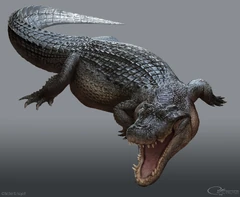
| |
| RJ Palmer's illustration of Deinosuchus rugosus | |
| Scientific classification | |
| Kingdom: | Animalia |
| Phylum: | Chordata |
| Class: | Reptilia |
| Order: | Crocodilia |
| Family: | Alligatoroidea |
| Genus: | †Deinosuchus |
| Type species | |
| †Deinosuchus hatcheri Holland, 1909 | |
| Other species | |
(Colbert & Bird, 1954)
(Emmons, 1858)
(Cosette & Brochu, 2020) | |
| Synonyms | |
| |
Deinosuchus was a genus of large crocodyliform that lived from 82-73 million years ago. Its main competitors as a large predator may have included sharks, marine reptiles like mosasaurs, theropods like the tyrannosaurs and other Deinosuchus. Its main prey were sea turtles and dinosaurs.
Deinosuchus is an extinct relative to Crocodiles and Alligators, however studies of its brain case suggest it was more closely related to Alligators. The name means "terrible crocodile" in Greek because deinos (δεινός), "terrible", and soukhos (σοῦχος), "crocodile". The first fossils were discovered in North America in the 1850s; the species was named and described in 1909. Additional fragments were discovered in the 1940s and were later incorporated into an inaccurate skull reconstruction at the American Museum of Natural History. Deinosuchus remains incomplete, but better skull material found in recent years has expanded understanding of this massive alligatoroid.
It lived on both sides of the Western Interior Seaway which was an ancient inland sea that divided North America In the Cretaceous. This sea was teeming with mosasaurs, pterosaurs and predators that would have outcompeted any other carnivore but not Deinosuchus because it was an opportunistic apex predator that was a lot larger than most of the carnivores in this ocean such as Xiphactinus. It lived on both sides of this ocean around the coastal regions of eastern and western North America. Deinosuchus reached its largest size in its western habitat, but the eastern populations were far more common. Opinion remains divided as to whether these two populations represent separate subspecies. Deinosuchus was probably capable of killing and eating large dinosaurs. It may have also fed on turtles, fish, and other aquatic and terrestrial prey. Deinosuchus died out before the Cretaceous-Paleogene Extinction Event.
Description[]
Size[]
Deinosuchus' huge size has been generally recognized despite the fragmentary nature of the fossils assigned to the genus. Size estimates have varied considerably over the years.
The original estimate for the holotype specimen by Colbert and Bird (1954), reconstructed using similar proportions to the cuban crocodile gave a total length of 15 meters (49 feet). Colbert and Bird stated that this was a "conservative" reconstruction, since an even greater length could have been obtained if a long-skulled modern species such as the saltwater crocodile had been used as the template.[7] Because it was not then known that Deinosuchus had a broad snout, Colbert and Bird miscalculated the proportions of the skull, and the reconstruction greatly exaggerated its overall width and length.[11]
This reconstruction is now considered inaccurate. Using more complete remains, size estimates attained for specimens varied from 8-12 meters (26-33 feet) and 2.5-14 tonnes (depending on the species).

The largest Deinosuchus hatcheri specimens by Fadeno
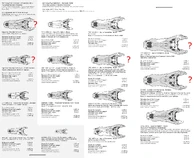
Deinosuchus skull chart by Fadeno
However the largest fragmentary remains of Deinosuchus, were 1.5 times larger than that of average sized specimens, David Schwimmer (2002) determined the largest individiuals may have reached 12 meters (39 feet) and perhaps weighed as much 8.5 tonnes. James Farlow (2005) estimated that a particularly large mandible would have came from an individual with a skull length of 147.5 cm (4.84 feet) and using similar regressions with the American Alligator, estimated the total body length at 10.6 meters (35 feet) for this particular specimen.
According to David Schwimmer in 2018, maximum size estimates ranged from 10.6 - 13.7 meters (35 - 45 feet); indicating the largest individuals may have been large than previously known.

Deinosuchus rugosus reconstruction by Fadeno
Due to the fragmentary nature and lack of complete fossils assigned to the genus; the exact size of the largest Deinosuchus individuals remains unknown.
The largest D. hatcheri specimens (TMM 43632-1 and CM 963) could reach sizes of 13 - 14.12 meters in length and 12 to 15 tonnes. That would not only make Deinosuchus the biggest crocodilian that ever lived, but also the biggest carnivorous archosaur.
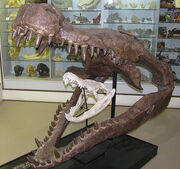
Deinosuchus Skull Cast vs. Alligator Skull
Paleobiology[]
Deinosuchus had a secondary bony palate, which would have allowed it to breathe through its nostrils while the rest of the head remained submerged underwater. The secondary palate and procoelous vertebrae are advanced features also found in modern crocodilians.The osteoderms covering the back of Deinosuchus were unusually large and deeply pitted; some were of a roughly semi-spherical shape. Deep pits and grooves on these osteoderms served as attachment points for connective tissues.Together, the osteoderms and connective tissues would have served as load-bearing reinforcement to support the massive body of Deinosuchus out of water. Consequently, despite its bulk, Deinosuchus was probably almost as agile on land as its modern relatives. Further studies in 2020, showed that Deinosuchus had banana sized teeth, a broad skull and broad, elongated heads which ended in a bulbous tip.
Distribution[]
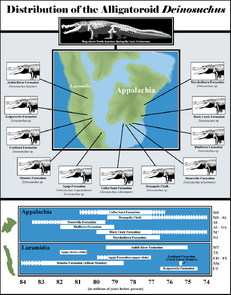
Deinosuchus distribution
A Deinosuchus jaw fragment, exhibited at the North Carolina Museum of Natural Sciences. Fossils of this large alligatoroid have been discovered in ten U.S. states, plus northern Mexico. Deinosuchus was present on both sides of the Western Interior Seaway. Specimens have been found in ten of the modern-day United States. A Deinosuchus osteoderm from the San Carlos Formation was also reported in 2006, so the crocodilian's range may have included parts of Mexico. Deinosuchus fossils are most abundant in region of Georgia, near the Alabama border. All known specimens of Deinosuchus were found in rocks that date to the Campanian stage of the Cretaceous. The oldest examples of this genus lived approximately 80 Ma, and the youngest lived around 73 million years ago
The distribution of Deinosuchus specimens indicates that these giant crocodilians may have preferred estuarine environments.[15] In the Aguja Formation of Texas, where some of the largest specimens of Deinosuchus have been found, these massive predators probably inhabited brackish-water bays.[19] Although some specimens have also been found in marine deposits, it is not clear whether Deinosuchus ventured out into the ocean (like modern-day saltwater crocodiles); these remains might have been displaced after the animals died.[15] Deinosuchus has been described as a "conspicuous" component of a purportedly distinct biome occupying the southern half of Late Cretaceous North America.[20]
Diet[]
[1][2]Deinosuchus may have preyed upon large ornithopods. Kritosaurus, shown above, lived alongside the giant crocodilian in the Aguja Formation ecosystem.[21]In 1954, Edwin H. Colbert and Roland T. Bird speculated that Deinosuchus "may very well have hunted and devoured some of the dinosaurs with which it was contemporaneous".[7] Colbert restated this hypothesis more confidently in 1961: "Certainly this crocodile must have been a predator of dinosaurs; otherwise why would it have been so overwhelmingly gigantic? It hunted in the water where the giant theropods could not go."[22][23] David R. Schwimmer proposed in 2002 that several hadrosaurid tail vertebrae found near Big Bend National Park show evidence of Deinosuchus tooth marks, strengthening the hypothesis that Deinosuchus fed on dinosaurs in at least some instances.[4] In 2003, Christopher A. Brochu did not find the tooth mark evidence to be compelling, but nonetheless agreed that Deinosuchus "probably dined on ornithopods from time to time."[24] Deinosuchus is generally thought to have employed hunting tactics similar to those of modern crocodilians, ambushing dinosaurs and other terrestrial animals at the water's edge and submerging them until they drowned.[25]
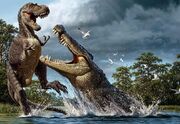
a Deinosuchus attacks an Albertosaurus
Schwimmer and G. Dent Williams proposed in 1996 that Deinosuchus may have preyed on marine turtles.[26] Deinosuchus would probably have used the robust, flat teeth near the back of its jaws to crush the turtle shells.[4] The "side-necked" sea turtle Bothremys was especially common in the eastern habitat of Deinosuchus, and several of its shells have been found with bite marks that were most likely inflicted by the giant crocodilian.[4][26]
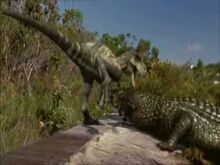
Deinosuchus as depicted on Prehistoric park, attacking one of the Park's Tyrannosaurus.
Schwimmer concluded in 2002 that the feeding patterns of Deinosuchus most likely varied by geographic location; the smaller Deinosuchus of eastern North America would have been opportunistic feeders in an ecological niche similar to that of the modern American alligator. They would have consumed marine turtles, large fish, and smaller dinosaurs.[3] The bigger, but less common, Deinosuchus that lived in Texas and Montana might have been more specialized hunters, capturing and eating large dinosaurs.[3] Schwimmer noted that no theropod dinosaurs in Deinosuchus's eastern range approached its size, indicating that the massive crocodilian could have been the region's apex predator.[4]
Growth rates 1999 study by Gregory M. Erickson and Christopher A. Brochu suggested that the growth rate of Deinosuchus was comparable to that of modern crocodilians, but was maintained over a far longer period of time.[13] Their estimates, based on growth rings in the dorsal osteoderms of various specimens, indicate that each Deinosuchus might have taken over 35 years to reach full adult size, and that the oldest individuals may have lived for more than 50 years.[13] This was a completely different growth strategy than that of large dinosaurs, which reached adult size much more quickly and had shorter lifespans.[13] According to Erickson, a full-grown Deinosuchus "must have seen several generations of dinosaurs come and go".[27]Schwimmer noted in 2002 that Erickson and Brochu's assumptions about growth rates are only valid if the osteodermal rings reflect annual periods, as they do in modern crocodilians.[3] According to Schwimmer, the growth ring patterns observed in Deinosuchus could have been affected by a variety of factors, including "migrations of their prey, wet-dry seasonal climate variations, or oceanic circulation and nutrient cycles".[ If the ring cycle was biannual rather than annual, this might indicate that Deinosuchus grew faster than modern crocodilians, and had a similar maximum lifespan.[3]
Discovery and naming[]
[3][4] Ebenezer Emmons illustrated two fossil teeth in 1858. Most likely, they belonged to the crocodilian that would later be named Deinosuchus.In 1858, geologist Ebenezer Emmons described two large fossil teeth found in Bladen County, North Carolina.[28] Emmons assigned these teeth to Polyptychodon, which he then believed to be "a genus of crocodilian reptiles".[28] Later discoveries showed that Polyptychodon was actually a pliosaur, a type of marine reptile.[11] The teeth described by Emmons were thick, slightly curved, and covered with vertically grooved enamel; he assigned them a new species name, P. rugosus.[28] Although not initially recognized as such, these teeth were probably the first Deinosuchus remains to be scientifically described.[11] Another large tooth that likely came from Deinosuchus, discovered in neighboring Sampson County, was named Polydectes biturgidus by Edward Drinker Cope in 1869.[11]In 1903, at Willow Creek, Montana, several fossil osteoderms were discovered "lying upon the surface of the soil" by John Bell Hatcher and T.W. Stanton.[10]These osteoderms were initially attributed to the ankylosaurid dinosaur Euoplocephalus.[10]
Excavation at the site, carried out by W.H. Utterback, yielded further fossils, including additional osteoderms as well as vertebrae, ribs, and a pubis.[10] When these specimens were examined, it became clear that they belonged to a large crocodilian and not a dinosaur; upon learning this, Hatcher "immediately lost interest" in the material.[10] After Hatcher died in 1904, his colleague W.J. Holland studied and described the fossils.[10] Holland assigned these specimens to a new genus and species, Deinosuchus hatcheri, in 1909.[10] Deinosuchus comes from the Greek δεινός/deinos, meaning "terrible", and σοῦχος/suchos, meaning "crocodile". This skull reconstruction, exhibited at the American Museum of Natural History for nearly a half-century, is probably the best known of all Deinosuchus fossils. The darker shaded portions are actual fossil bone, while the light portions are plaster.A 1940 expedition by the American Museum of Natural History yielded more fossils of giant crocodilians, this time from Big Bend National Park in Texas.[These specimens were described by Edwin H. Colbert and Roland T. Bird in 1954, under the name Phobosuchus riograndensis.[7] Donald Baird and Jack Horner later assigned the Big Bend remains to Deinosuchus, which has been accepted by most modern authorities.[11][29]
The genus name Phobosuchus, which was initially created by Baron Franz Nopcsa in 1924, has since been discarded because it contained a variety of different crocodilian species that turned out to not be closely related to each other.[11]The American Museum of Natural History incorporated the skull and jaw fragments into a plaster restoration, modeled after the present-day Cuban crocodile.[7] Colbert and Bird stated that this was a "conservative" reconstruction, since an even greater length could have been obtained if a long-skulled modern species such as the saltwater crocodile had been used as the template.[7] Because it was not then known that Deinosuchus had a broad snout, Colbert and Bird miscalculated the proportions of the skull, and the reconstruction greatly exaggerated its overall width and length.[11] Despite its inaccuracies, the reconstructed skull became the best-known specimen of Deinosuchus, and brought public attention to this giant crocodilian for the first time.[11]
Skull cast of Deinosuchus at the American Museum of Natural History Numerous additional specimens of Deinosuchus were discovered over the next several decades. Most were quite fragmentary, but they expanded knowledge of the giant predator's geographic range. As noted by Christopher A. Brochu, the osteoderms are distinctive enough that even "bone granola" can adequately confirm the presence of Deinosuchus.[11][30] Better cranial material was also found. David R. Schwimmer was able to create a composite computer reconstruction of 90% of the skull.[1]
Deinosuchus scutes and vertebra, Carnegie Museum of Natural History. Deinosuchus was classified in the family Crocodylidae by Colbert and Bird, primarily on the basis of dental features resembling those of modern crocodiles. However, a phylogenetic re-evaluation conducted in 1999 by Brochu determined that Deinosuchus was actually a primitive member of Alligatoroidea. This classification was bolstered in 2005 by the discovery of a well-preserved Deinosuchus braincase from the Blufftown Formation of Alabama, which shows some features reminiscent of those in the modern American alligator. Although it was a prehistoric member of the same clade, Deinosuchus was not a direct ancestor of modern alligators. Its closest relatives may have been Leidyosuchus and Diplocynodon.
Schwimmer considered all Deinosuchus specimens to belong to one species. He noted that there were more similarities than differences between the eastern and western populations, and that most of these differences related only to the larger size of the western specimens. Under the International Code of Zoological Nomenclature's rules of priority, this species would be named D. rugosus. Lucas et al. Also considered Deinosuchus a monospecific genus. However, Brochu questioned Schwimmer's analysis, suggesting that size might be a significant diagnostic feature and that several of the features used by Schwimmer to establish synonymy between the two populations are actually primitive traits shared by other genera as well. Schwimmer informally referred to the western populations as D. riograndensis, and several other researchers, including Anglen and Lehman and Westgate et al.

Deinosuchus schwimmeri compared to Deinosuchus hatcheri (by Fadeno)
In 2020, a new species (Deinosuchus schwimmeri) was named in honor of Columbus State University professor David Schwimmer, who is known for his contributions to the research of Deinosuchus. Further studies indicated the D. rugosus was misidentified and likely came from D. riograndensis or D. schwimmeri, both species of which, were described later but boasted more complete sets of fossils. The species status of the terror croc D. hatcheri, due to its fragmentary fossil evidence, is also questionable, as reported by the authors.
In popular culture[]
- Deinosuchus appears on 2 Hanna-Barbera action shows The Lost Valley & Mighty Mightor.
- Deinosuchus appeared on Dinosaur Train.
- A Deinosuchus appeared on the 5th episode of Journey to the Center of the Earth “Creatures of the Swamp”.
- A Deinosuchus name Dil appears in The Land Before Time IV: Journey Through the Mists.
- A Deinosuchus appears in Paleoworld, however the sizing was inaccurate.
- The Deinosuchus appears in Walking with Dinosaurs: The Death of a Dynasty, where it almost killed a Quetzalcoatlus.
- It was the focal creature in an episode of Prehistoric Park, where it was greatly oversized.
- Deinosuchus also appears in Dino Dan: Trek's Adventures and Dino Dana.
- Two Deinosuchus appeared in an episode of Primeval, being "Fire and Water", where the duo exited an anomaly into Maidenhead, England. There they would be found preying on a Velociraptor before being darted and moved to the Creature Prison.
- Deinosuchus was featured in Dinosaur Train. Deanna Deinosuchus appeared in 2 episodes: Tiny & the Crocodile, & Classic in the Jurassic: Air, Water and Land.
- The Deinosuchus is in The Isle.
- Deinosuchus appeared on 3 Video Games: The Lost World Jurassic Park (Arcade), Savage Quest (Arcade) & Jurassic Park Builder.
- During Jurassic World: Fallen Kingdom while Eli Mills presents the Indoraptor via hologram, the Indominus rex hologram shows that it had Deinosuchus DNA used for the number of teeth it has. This likely hints that the Indominus rex also had Deinosuchus DNA acquired by InGen for the hybrid.
- A large crocodilian resembling Deinosuchus appears in the 2019 movie Crawl.
- Deinosuchus appears in the Lake Placid movie series as the main antagonist.
- Deinosuchus is in the movie The Hatchling as the antagonist.
- Deinosuchus appears as "Super gator" in the movie Supergator and Dinocroc (Sarcosuchus) vs Supergator.
- Deinosuchus made an appearance in the ROBLOX game called Dinosaur Simulator.
- Deinosuchus appear in Tasty Planet: Back for Seconds in the level beware of deinosuchus.
References[]
- https://museum.wa.gov.au/explore/dinosaur-discovery/deinosuchus
- https://hakaimagazine.com/news/when-deinosuchus-ruled-the-earth/
- https://www.thoughtco.com/overview-of-deinosuchus-1093481
- https://www.syfy.com/syfy-wire/ancient-terror-crocodile-deinosuchus-ate-dinosaurs
- https://winghamwildlifepark.co.uk/dinosaur/deinosuchus/
- http://www.sci-news.com/paleontology/deinosuchus-schwimmeri-08730.html
- https://peerj.com/articles/11302/
- https://www.kidsnews.com.au/animals/meet-deinosuchus-the-massive-terror-croc-with-bananasized-teeth/news-story/cb7a758415d039abb6e194190ea5e92c
- https://www.tandfonline.com/doi/full/10.1080/02724634.2020.1767638
- https://www.eurekalert.org/news-releases/704896
- https://www.nationalgeographic.com/animals/article/100323-giant-croc-crocodile-dinosaurs-deinosuchus-feces-poop
- https://www.dinosaurpark.org/deinosuchus
- https://www.researchgate.net/publication/351023265_First_remains_of_the_enormous_alligatoroid_Deinosuchus_from_the_Upper_Cretaceous_Menefee_Formation_New_Mexico
- https://www.deviantart.com/fadeno/art/Deinosuchus-hatcheri-multiview-skeletal-850628356